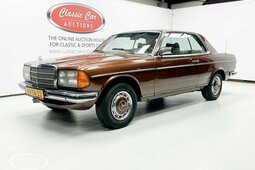The history of the Mercedes-Benz five-cylinder engine is one of simplicity, yet engineering excellence. Throughout the decades, Mercedes has pioneered advancements in various sectors of automotive engineering, be it safety, efficiency or longevity. One of the maker's most significant leaps forward was bringing efficient diesel power to everyday motoring, where the five-cylinder configuration holds a unique place in Mercedes’ history. Yet today – it is mostly forgotten not just by the German manufacturer, but by everyone else who once crafted their own unique 5-pot engines. How did it all start and where did it end?
The Origins of the 5-Cylinder Engine
During the 1970s, the automotive industry was facing an energy crisis, prompting manufacturers to seek more fuel-efficient solutions without compromising performance. Mercedes-Benz, being at the top of their game in the late 20th century, recognized how lucrative and advantageous a powerful yet economical diesel passenger car could be.
Mercedes engineers began experimenting with unconventional cylinder configurations. While four-cylinder engines offered efficiency, they often lacked the power needed for larger vehicles. Six-cylinder engines provided smoothness and power but were heavier and less fuel-efficient. The five-cylinder engine presented an optimal balance, offering increased power over a four-cylinder while being lighter and more efficient than a six-cylinder.
The First 5-Cylinder Diesel Engine: OM617 (1974-1991)
Mercedes-Benz introduced the world’s first five-cylinder passenger car engine in 1974 with the OM617. This naturally aspirated 3.0-liter diesel engine was an evolution of the four-cylinder OM616 and was initially launched in the W115 chassis Mercedes-Benz 240D 3.0. The OM617 was a breakthrough for diesel engines in passenger cars, providing better performance than its four-cylinder counterparts while maintaining great fuel economy.
The OM617 was praised for its bulletproof reliability, often exceeding 500,000 miles with routine maintenance. It gained immense popularity in models such as the W123 300D and W126 300SD, particularly in North America, where cars with diesel engines were very scarce.
Turbocharging: OM617A (1978-1991)
The OM617 received a significant performance boost in 1978 with the introduction of a turbocharged variant, the OM617A. Found in models like the W116 300SD and later the W126, this engine addressed the sluggish performance often associated with diesel engines of the time. The turbocharged OM617 produced around 121 horsepower and significantly improved torque.
The OM602: The Next Generation (1985-2002)
As emissions regulations became stricter in the 1980s, Mercedes developed the OM602, a more refined and efficient 5-cylinder diesel engine. This 2.5-liter engine replaced the OM617 in many applications, bringing with it significant advancements in fuel economy and emissions control.
The OM602 was used in various models, including the W201 190D 2.5, W124 250D, and W463 G-Class. Its turbocharged versions, such as the OM602.962, were known for their pleasant performance and great usability. Unlike the OM617, the OM602 featured an aluminum cylinder head for better heat dissipation and engine weight reduction.
The M103 Gasoline Experiment
Though Mercedes-Benz predominantly used the five-cylinder layout for diesel applications, there was one gasoline-powered five-cylinder engine prototype. The M103, a well-known inline-six from the 1980s, was occasionally tested in a five-cylinder variant, but it never saw widespread production. Ultimately, Mercedes preferred even-numbered cylinder counts for gasoline engines due to smoother operation and manufacturing simplicity.
Later Developments and the Transition Away from the 5-Cylinder
By the early 2000s, Mercedes-Benz began transitioning away from five-cylinder engines. The OM647 and OM612, later developments of the OM602, were some of the last five-cylinder diesels used in passenger cars before being phased out in favor of four-cylinder and six-cylinder powerplants that met evolving emissions standards. Notably, the five-cylinder diesel persisted in commercial applications, particularly in Mercedes-Benz Sprinter vans and military vehicles, due to its robust design and torque characteristics.
The very last 5-cylinder diesel Mercedes was the E270 CDI of the W211 generation. It was built until 2006 and pushed the sedan forward with 175 horsepower and 425 newton meters of torque. And even though this generation of Mercedes gets some bad press for reliability issues like the complicated semi-electronic brake system and corrosion prone body, the engine is without a shadow of doubt the most dependable bit of that car. It’s not just the 5-cylinder – the whole family of OM diesel engines from that generation were very strong, still rolling around in 2025 with ease, that is if the body hasn’t rotten away.
The Legacy
The OM617, in particular, is legendary for its durability, with many examples still running today after several decades of use. Its ability to withstand extreme conditions made it a favorite for off-road enthusiasts, biodiesel conversions, and even endurance racing. OM617 powered Mercs are almost the official symbol of African taxis and Balkan uncle cars, where these Mercs are still rolling around to this day. Mercedes-Benz’s pioneering work with the five-cylinder engine laid the foundation for future advancements in diesel technology. Though modern regulations have shifted the industry toward smaller displacement engines with turbocharging and hybridization, the five-cylinder legacy lives on in classic Mercedes-Benz models that will probably outlive the newer, more complicated ones.
For the same reasons the 5-cylinder engine in general has become almost extinct. Throughout history, Volvo, Audi, Mercedes, Fiat, General Motors and even Honda had 5 cylinder engines in their line-up. Even though they had varying degrees of success, for Audi and Volvo, the 5-cylinder defined an era. Think Audi Quattro, Audi RS2 and Volvo 850R – cars that would have been completely different if they never had those engines under the hood. The same thing goes for Mercedes, because 5-cylinder diesel powered models were produced in some of the highest volumes across the brand’s lifespan. The 5-cylinder is what shaped the brand world-wide.
---
Embark on a journey to find your ideal vehicle by browsing through our Car Categories. Or, delve into our Classic Passion Shop for an exciting array of products from our partners, perfect for enthusiasts looking to enhance their collection!













